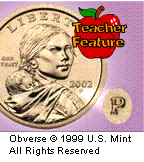
41.
How much was in that first batch?
The Mint produced its first circulating coins—all $111.78 worth of them—in March 1793. That first batch consisted of 11,178 copper cents. Soon after, the Mint began issuing gold and silver coins as well.
42.
Groove-y edges made them harder to copy.
The dollar, half-dollar, quarter, and 10-cent (dime) denominations were originally produced from precious metals (gold and silver). The reeded edges were created to make sure no one would alter the coins and try to file off the edges to retrieve some of the precious metals.
43.
How can you tell where a coin came from?
Mint marks show what minting facility your coins came from—"P" for Philadelphia, "D" for Denver, and "S" for San Francisco. This mark can be found to the right of the subject's face on the obverse side of each circulating coin—with the exception of the "Philadelphia" Lincoln cent, which has no mint mark.
44.
We used to trade gold, silver, and copper.
A 1792 law directed American money to be made of gold, silver and copper. Gold was used in the $10, $5, and $2.50 pieces. The dollar, half dollar, quarter, dime, and half dime were composed of silver. The cent and half cent were made of copper.

45.
It was much too royal for George Washington's taste.
President Washington, if here today, might be a bit surprised to find himself on the quarter. In considering designs for the first U.S. coins, he and Congress rejected designs picturing him. Why? Too much like monarchy, they said, the very thing from which the United States had rebelled. But in 1899, Washington's image was placed on a U.S. coin—the Lafayette dollar. In 1932, Washington appeared once again on a U.S. coin—the quarter—and still does today.
46.
The Mint wasn't always part of the Treasury.
From 1799 to 1873, the Mint was an independent agency reporting directly to the President. The Mint became part of the Department of the Treasury in 1873, and remains so today.

47.
For safe-keeping, you just can't beat Fort Knox.
To protect them from any possible danger during World War II, the Declaration of Independence, the Constitution, and the Bill of Rights were secretly stored in protective vaults at the U.S. Bullion Depository at Fort Knox, Kentucky. Only when Allied victory was assured in 1944 were the historic documents returned to Washington, D.C.
48.
Each President gets bronzed.
Though their importance as diplomatic symbols has faded, the Mint tradition of producing a medal for each president continues today as the "Presidential Medal" series. Bronze versions of all presidential medals are still available from the Mint.
49.
George Washington was our first President—but not the first President on a circulating coin.
In 1909, President Lincoln appeared on a one-cent coin and became the first real person—as well as the first American president—to have his face appear on a regular-issue American coin.
50.
Who arms the Armed Forces with medals?
The Mint once produced military decorations for the nation's armed forces, including the Silver Star, Bronze Star, Purple Heart and the Navy Cross. Currently, by order of Congress, the Mint produces gold Congressional Medals to be presented as a symbol of national appreciation for distinguished achievements. These commissioned medals can be presented to honor individuals, institutions or events of national significance.



